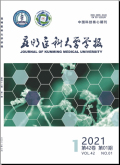昆明医科大学学报2024,Vol.45Issue(7):119-125,7.DOI:10.12259/j.issn.2095-610X.S20240718
hs-CRP、CCL2、CCL3与新生儿细菌感染病情关系及疗效预测价值
Relationship between hs-CRP,CCL2,CCL3 and Neonatal Bacterial Infection and Their Predictive Value for Efficacy
摘要
Abstract
Objective To explore the application value of high-sensitivity C-reactive protein(hs-CRP),chemokine CC motif ligand(CCL),and CCL3 in the treatment of neonatal bacterial infections.Methods A total of 70 cases of neonatal bacterial infection admitted to the People's Hospital of Langfang City from January 2021 to January 2023 were selected as the bacterial infection group.In addition,70 cases of neonatal viral infection and 70 cases of non-infected newborns were selected as the viral infection group and control group,respectively,at a ratio of 1∶1.The serum hs-CRP,CCL2,and CCL3 levels of the three groups and the bacterial infection group were compared at admission,the serum levels of each index were compared among the bacterial infection group with different therapeutic effects,and a receiver operating characteristic curve(ROC)was drawn to analyze the predictive efficacy of each serum index on therapeutic effects.The relative risk(RR)was used to analyze the impact of different expression of each serum index on the therapeutic effect of neonatal bacterial infection.Results The expressions of hs-CRP,CCL2 and CCL3 in the bacterial infection group and viral infection group at admission were higher than those in the control group(P<0.05).The expressions of hs-CRP,CCL2 and CCL3 in severe children with bacterial infection at admission were higher than those in mild children(P<0.05).The levels of hs-CRP,CCL2 and CCL3 in the ineffective subgroup were higher than those in the effective subgroup at admission,24 h,3rd day and 5th day(P<0.05).The combined effect of serum hs-CRP,CCL2 and CCL3 on neonatal bacterial infection at admission,24 h,3 d and 5 d was better than that of single index at each time point,and the combined prediction of AUC at 24 h was the largest.According to the cut-off value of each index 24 hours after admission,the risk of treatment failure in children with high expression of hs-CRP,CCL2 and CCL3 was 3.577 times,3.357 times and 2.630 times higher than that in children with low expression.Conclusions hs-CRP,CCL2 and CCL3 are highly expressed in the serum of neonatal bacterial infection,and they are closely related to the severity of the disease and the therapeutic effect of the children.The combination of the three serum indicators has good reference value in predicting the therapeutic effect of the children.关键词
ROC曲线/hs-CRP/炎症趋化因子/新生儿细菌感染/治疗效果/价值Key words
ROC curve/hs-CRP/Inflammatory chemokines/Neonatal bacterial infection/Therapeutic effect/Value分类
临床医学引用本文复制引用
袁振兴,孙文菲,王卫东..hs-CRP、CCL2、CCL3与新生儿细菌感染病情关系及疗效预测价值[J].昆明医科大学学报,2024,45(7):119-125,7.基金项目
河北省医学科学研究课题计划(20201302) (20201302)

